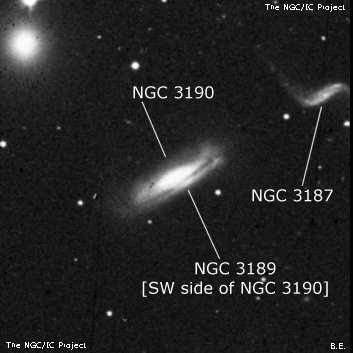
William Herschel discovered NGC 3190 = H II-44 = h692, along with NGC 3193, on 12 Mar 1784 (sweep 166) and recorded, "Two small nebulae; very like each other; both E and both lbM; than towards the ends, but of the resolvable kind." His single position is closer to NGC 3187, but must refer to the brighter galaxies though NGC 3193 is not noticeably elongated.
R.J. Mitchell sketched the galaxy on 22 Mar 1857 (plate XXVII, fig 14 in LdR's 1861 publication) and clearly showed two strips of the galaxy separated by a dark lane.
300/350mm - 13.1" (3/24/84): bright, small bright nucleus, elongated NW-SE, brightest in a group. Two mag 8 stars are in the field.
400/500mm - 17.5" (3/23/85): bright, edge-on NW-SE, stellar nucleus, fairly large. Brightest in HCG 44 with NGC 3187 4.9' NW, NGC 3193 5.8' NE and NGC 3185 11' SW. Two bright stars are in the field; mag 7.8 SAO 81276 8.3' NNW and mag 9.0 SAO 81279 6.5' NE.
900/1200mm - 48" (4/1/11): extremely bright, large, nearly edge-on 7:2 WNW-ESE, 3.7'x1.0', very bright core with a dazzling stellar nucleus embedded. A sharp, contrasty dust lane that is relatively wide runs along the full length of the galaxy, passing just south of the core. A thin strip of the galaxy parallels the dust lane on the outer southwest side of the galaxy. This strip has a well-defined southern edge and dims at the southeast end of the galaxy. Dreyer catalogued the strip as NGC 3189 based on the 1850 sketch using Lord Rosse's 72-inch scope.
Notes by Steve Gottlieb